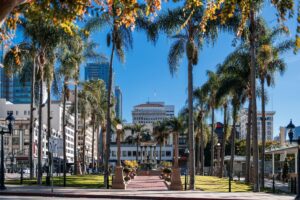California-San Diego: Preserving Affordable Housing
Introduction:
Preserving affordable housing units in the City of San Diego is an essential element of a balanced approach that combines preservation and new construction to address the affordable housing and homelessness challenges the City is experiencing. The City of San Diego (City) is facing affordable housing and homelessness crises, with more than half of all renter households (54 percent) spending more than 30 percent of their income on housing (cost-burdened).

Addressing this crisis requires both the creation of new affordable housing and the preservation of affordable rental housing that currently exists in the City. The San Diego Housing Commission (SDHC) collaborates with the federal government, the State of California, the City, and the local housing community to address these housing challenges for households with low income throughout the City.
Financial Analyses of Unrestricted, Naturally Occurring Affordable Housing:
Preservation of existing unrestricted, naturally occurring affordable housing (NOAH) can be more cost effective on a per-unit basis than producing new units affordable at 60 percent of AMI because the private sector has already made major upfront expenditures to entitle and improve the property. Nevertheless, a financing gap (the difference between the development cost and the sources of funds) was found in each typology studied, both with and without Low-Income Housing Tax Credit (LIHTC) subsidies. As part of this report, three typologies were studied based on estimated loss of affordability and existing prevalence of unrestricted NOAH units. Based on this study, three trends emerged:
• Larger NOAH properties tend to have lower total development costs per unit and may deliver a better return to investment than smaller buildings.
• Even with tax-exempt bond financing, a persistent financing gap remains to preserve units at 60 percent of AMI.
• NOAH preservation projects have a large amount of inherent risk and variability from project to project.
Preserving Affordable Housing Framework:
The continued shortage of affordable housing in the City threatens the quality of life for those who live here. Without intervention, at-risk affordable homes10 will continue to be lost. San Diego cannot solely rely on new construction of housing units to mitigate the housing affordability crisis the City faces; this necessitates a robust preservation strategy. The recommendations in this report provide a framework for further study and are based on a review of best practices from other cities in California and around the nation. They are grouped into four categories:
• Capital Resources
• Preservation Policies
• Tenant Protections
• Capacity Building
The Rental Housing Gap:
The current affordable housing availability gap measures the difference between what San Diego City residents can afford to pay in rent (need) and the housing options affordable17 to them at that price point (availability). These gaps are summed cumulatively for each income threshold, as each household can afford any unit below their income threshold.
Multifamily Rental Housing:
Multifamily rental housing with five or more units can be further subdivided into deed-restricted units and unrestricted units. Deed-restricted units are units with liens or covenants recorded on the property that set binding maximum rent restrictions, often based on federal, state, or city programs that subsidize the development or operation of the units. Unrestricted rental housing units do not have any specific rent restrictions recorded on the property.
Conclusion:
Dedicating sufficient resources to support the acquisition and rehabilitation of preserving affordable housing is essential to promote the preservation of deed-restricted and unrestricted housing in the City. Without adequate resources, neither nonprofit nor for-profit developers will be able to pursue preservation projects in San Diego. In fact, none of the policy levers recommended in the latter portion of this report will be meaningful without dedicated sources of funding for preservation.
Also Read: Measures for Property Developers to Finance Affordable Housing Construction
